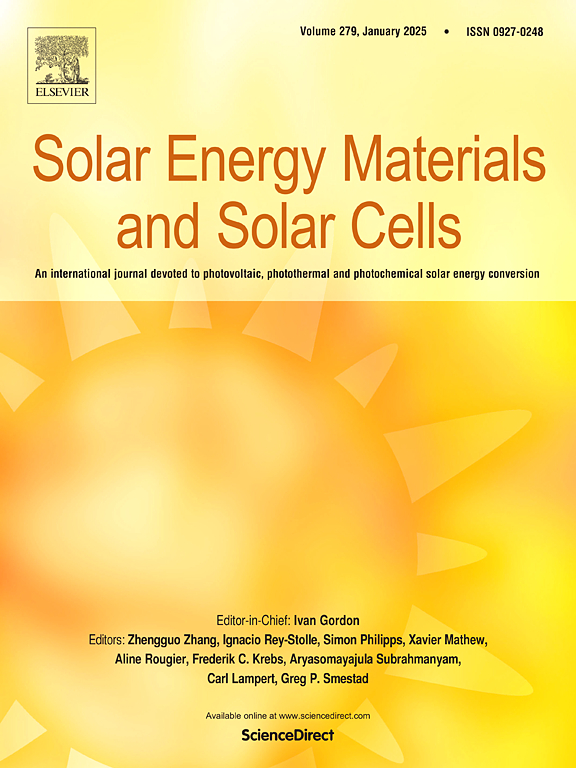Gas bubbles and blisters in thin film cadmium selenide deposited by magnetron sputtering
IF 6.3
2区 材料科学
Q2 ENERGY & FUELS
引用次数: 0
Abstract
Cadmium Selenide (CdSe) is a source of Selenium in CdSeTe/CdTe photovoltaic device fabrication. CdSe thin films have been deposited using pulsed DC magnetron sputtering. The thin films are high quality, compact with the columnar structure usually associated with sputtered thin films. The thin films exhibit mixed hexagonal and cubic phases due to the presence of stacking faults. Argon is observed to be present in the as-deposited films, implanted during film growth from the sputter-working gas. The thin films have been exposed to high temperature annealing treatments and to cadmium chloride (CdCl2) activation to assess microstructural changes that occur. After annealing, voids appear in the film caused by the growth of argon gas bubbles. This leads to blistering on the CdSe surface. The CdCl2 treatment causes even more serious void formation and surface blistering. Similar problems have been observed with sputtered CdTe thin films. Argon gas atoms are trapped in the growing films by stacking faults. When the stacking faults are removed by the high temperature treatments, the argon diffuses into gas bubbles. These bubbles continue to expand causing serious voiding and catastrophic blistering. Although, the phenomenon can be mitigated by increasing the substrate temperature and by reducing the deposition rate, argon gas bubbles are still formed. Voiding is a serious problem in photovoltaic device fabrication, but the problem can be resolved by using an evaporative deposition technique to avoid argon implantation. The use of sputter-deposition of CdTe and CdSe should be avoided in the fabrication of high efficiency photovoltaic devices.
磁控溅射沉积硒化镉薄膜中的气泡和水泡
硒化镉(CdSe)是CdSeTe/CdTe光伏器件制造中硒的来源。采用脉冲直流磁控溅射技术制备了CdSe薄膜。薄膜质量高,致密,具有通常与溅射薄膜相关的柱状结构。由于层错的存在,薄膜呈现出混合的六方相和立方相。在沉积的薄膜中观察到氩的存在,这是在薄膜生长过程中由溅射工作气体注入的。薄膜暴露于高温退火处理和氯化镉(CdCl2)活化,以评估发生的微观结构变化。退火后,由于氩气气泡的生长,薄膜中出现空洞。这导致CdSe表面起泡。CdCl2处理导致更严重的空隙形成和表面起泡。在溅射碲化镉薄膜中也观察到类似的问题。由于层错,氩气原子被困在生长的薄膜中。当通过高温处理消除层错后,氩气扩散成气泡。这些气泡继续膨胀,导致严重的排空和灾难性的起泡。虽然可以通过提高衬底温度和降低沉积速率来缓解这一现象,但仍会形成氩气气泡。真空是光伏器件制造中的一个严重问题,但利用蒸发沉积技术可以避免氩注入。在高效光电器件的制造中,应避免使用CdTe和CdSe溅射沉积的方法。
本文章由计算机程序翻译,如有差异,请以英文原文为准。
求助全文
约1分钟内获得全文
求助全文
来源期刊

Solar Energy Materials and Solar Cells
工程技术-材料科学:综合
CiteScore
12.60
自引率
11.60%
发文量
513
审稿时长
47 days
期刊介绍:
Solar Energy Materials & Solar Cells is intended as a vehicle for the dissemination of research results on materials science and technology related to photovoltaic, photothermal and photoelectrochemical solar energy conversion. Materials science is taken in the broadest possible sense and encompasses physics, chemistry, optics, materials fabrication and analysis for all types of materials.
 求助内容:
求助内容: 应助结果提醒方式:
应助结果提醒方式:


